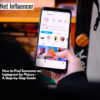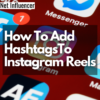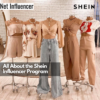Agency
Gaming Innovation Meets Convenience: Breaking Down UMI Games’ Sheetz Fortnite Integration
Convenience store chain Sheetz partnered with gaming studio UMI Games to create their first-ever fully custom Fortnite experience: “Sheetz Run: Only Up!”
The collaboration, launched in January 2024, transformed Sheetz’s made-to-order (MTO) food system into interactive gameplay choices through custom-built environments featuring giant hamburgers, a french fry forest, and steaming coffee cups that launch players skyward.
With a $25,000 prize pool and integration across multiple physical and digital channels, the activation drew hundreds of thousands of players and created an active community of speed-runners competing to reach the summit in record time.
UMI Games’ COO, Marina Escobar, and CTO, Onur Komili, reveal the strategic decisions, technical innovations, and community-building approaches that turned a marketing activation into an engaged gaming destination.
UMI Games: Bridging Brands and Gaming Creators
UMI Games, a Whalar Group company, specializes in connecting brands with creators within gaming platforms like Fortnite, Roblox, and Minecraft. The studio combines custom game development with creator partnerships to build immersive brand experiences.
“We do more than just build games,” explains Marina. “We help brands market within these worlds by leveraging the influence of creators and using the power of gaming platforms. We transform brand campaigns into immersive and unforgettable experiences for players.
Onur emphasizes their unique approach to brand integration: “Gamers are a particular bunch. They don’t like ads in their games. And if they see a branded game, they’ll assume it’s a low-effort game that won’t be fun. We take the opposite approach where we want the game to be fun first and foremost.”
Partnership Development and Goals
Initial discussions began in the spring of 2024, with Sheetz presenting specific brand requirements. The convenience chain wanted to build a safe, violent-free game while maintaining a fun, family-friendly atmosphere. They stressed the importance of authentically representing the store experience while reaching beyond their existing customer base to connect with both casual and hardcore gamers.
“They really knew what they wanted,” Marina recalls. “They came to us with a thoughtful one-sheet that clearly outlined their vision. It was incredible to read because it quickly taught us much about their brand, who they are, and how they wanted players to view them in the game. They knew their brand inside and out but didn’t know how to bring it to life in this space. That’s where we came in, and for them to trust us was essential.”
The development process unfolded over several months, beginning with the initial concept and pitch work last spring. “If you showed this game to somebody who’s a gamer of any type, and you stripped away some of the UI elements,” Onur notes, “People would say, I didn’t know [it was Fortnite]. Typically, I’d say 99% of maps, they all look very similar to one another.”
Game Development and Innovation
The technical team developed an elaborate game environment unlike anything previously seen in Fortnite.
“Nearly everything you see in the world was custom-made based on Sheetz foods, drinks, its red brick building, gas station, or whatever it may be,” Onur explains. “The fact that we were able to cram so much custom artwork, both textures, 3D models, visual effects, all that was, that sets us apart from a majority of maps.”
The development prioritized authenticity in representing the Sheetz brand experience. Each of the 14 themed chapters within the game showcases different aspects of Sheetz offerings, from “Burger Bluffs” featuring their food items to interactive MTO systems that mirror the actual store experience.
“We listened closely to our client’s vision and by repeating back what we heard, presenting concepts and refining the creative brief together – to ensure we were on the right track,” Marina notes.
The gameplay mechanics went beyond typical Fortnite conventions, incorporating player choice points that mirror real store options. “With the insights Sheetz shared about their store operations, along with their quirky tone and bold aesthetics, we were able to create a game that felt organic and fun while still aligning with what players expect,” Marina shares.
A checkpoint system ensured accessibility while maintaining competitive elements through robust time tracking.
Creator Integration Strategy
The studio carefully orchestrated a three-tiered creator approach. Five live streamers were selected specifically for their alignment with Sheetz’s brand values and engaging personalities. These streamers received customized gift boxes tailored to their personal interests and creative freedom within brand guidelines.
“When searching for Creators and talent, we researched profiles to make sure they fit our client’s criteria and approval,” Marina explains.
A second tier of eight content creators spread across YouTube, TikTok, and Instagram – bringing food and lifestyle content to the campaign. These creators integrated the Sheetz experience into their established content styles while meeting structured deliverable requirements. “We chose creators who connected with Sheetz’s values and brought a fun, energetic, and inclusive vibe,” emphasizes Marina.
The third tier comprised six Fortnite portal partners with significant existing player bases. These established map creators integrated custom-branded portals into their high-traffic maps, creating seamless pathways for players to discover the Sheetz experience. Onur notes, “These are existing maps with hundreds, thousands, tens of thousands players and concurrent users at any given time.”
Marketing Integration and Community Building
The physical integration strategy encompassed multiple touchpoints across the Sheetz retail environment.
“They’re very modern stores,” Onur shares. “They’ve got big screens, so they were playing video footage. Again, gameplay of the game.” Digital screens at gas pumps and in-store displays showcased the game, while promotional inserts in MTO bags and mobile app notifications drove customer awareness and participation.
The digital community grew around a Discord server that attracted over 1,500 members. “The competitive nature is awesome, but there’s also the fact that people are working together now,” Onur explains. “You can see people adding each other as friends in the Discord and saying, ‘Hey, let’s join a map together and study and practice and see what we can do to trim our time.'”
To reiterate, the competition itself offered a substantial $25,000 prize pool over its month-long duration. Top performers competed for significant rewards, with the fastest player earning $10,000, second place receiving $5,000, and places 11 through 25 awarded V-bucks gift cards.
Marina and Onur note that this tiered reward structure encouraged broad participation while maintaining competitive intensity.
Results and Impact
The project’s success exceeded initial expectations across multiple dimensions. “We’re seeing high engagement across the game – millions of views and hundreds of thousands of plays. We’re very happy,” Marina shares about the early metrics.
The depth of player engagement particularly stood out, with Onur noting, “There are at least a couple dozen people who have played the map at least a thousand times, practicing and trying to get better.”
The technical achievement garnered unexpected recognition from industry peers. “The fact that we got recognition not just from gamers, but from dev studios who actually do this for a living… they’re like, ‘Oh wow, how did you do that? I didn’t know it was possible,'” Onur reveals.
The community’s response proved gratifying for the team and the client. “When we shared comments from our Discord community with the client, they just kept saying, ‘That’s exactly what we wanted,’” Marina notes, highlighting how the organic growth in the community aligned perfectly with Sheetz’s brand values of inclusivity and authenticity.
Key Insights and Future Applications
The UMI Games executives see this partnership as a harbinger of future brand-creator collaborations in gaming.
“Part of the challenge is understanding how to show up in a way that feels authentic and engaging to players. Many brands recognize the need to be in this space, but most are still dipping their toe in, often through an integration,” Marina explains, revealing the current state of brand adoption in gaming spaces.
Onur points to broader industry trends driving this shift: “If you look at the trends over the last two or three years, you can see the number of brand activations in the metaverse… it’s going up, and it’s going up fast.”
The project revealed several crucial success factors in creator partnerships. Clear guidelines combined with creative freedom enabled authentic content development, while custom resources and support helped creators produce resonant content.
“You have to reach your target audience. And that is in Fortnite, Roblox, etc.,” Onur says. “Seeing brands put a bigger foothold into the gaming space is something we can expect to see as we continue growing and evolving.”





















